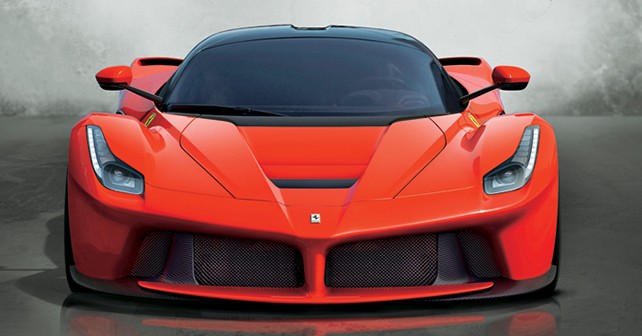
There’s a story floating around of a German client who had gone to Maranello a few months before the launch of the latest Cavallino hypercar to preorder one. The car costs, as is known, a million Euros, plus tax. After being told that in order to get on the waiting list, it was necessary to show a CV demonstrating the ownership of at least two Ferraris, he was apparently unruffled. So, as the story goes, he cut out two cheques on the spot and bought two models almost at full price, and, with them, the right to get onto the super exclusive list (comprising of 499 individuals) to secure a car whose hyperbole starts with its very name: LaFerrari. The intrinsically ultimate tone (The Ferrari) leaves no doubt as to the league it – and it alone - belongs to. Regardless of whether or not it actually transpired, the story helps us trace the contours of a world light years away from that of us common mortals, who couldn’t even think of taking a ride in the LaFerrari – let alone getting on an exclusive list to be hand picked to own one. And yet, it’s still unbelievably fascinating to go and look inside, to discover its secrets – perhaps because we know that it’s the artistic epitome of all the technology, aerodynamics, and design that can be found on four wheels.
Natural Selection
Months before its launch, we had already fully anticipated its mechanical supremacy. It’s the most powerful Ferrari ever (963 horsepower), and faster than ever of course. It’s also the first to have a hybrid engine. But, less is known about the creative process that gave the LaFerrari its current form – over the other options that were also considered. Over the last two years, there were a number of designs that were explored (some depicted here), with solutions that were both original and exciting. But, in the end, the tight interconnection of performance and design objectives gradually eliminated the less ‘efficient’ forms – a ruthlessly Darwinian selection. The first sketch was drawn at the end of 2010, when there were 10 designs at a scale of 1:4 vying for the attention of Maranello’s masterminds. In the spring of 2011, the number was halved, and the five survivors had been built as full-size models. A further elimination process cut the number down to three, then to two, and lastly to the one that prevailed. We are told a bit more about how this process of natural selection occurred by Flavio Manzoni, manager of the internal style centre (increasingly delegated with more responsibility) since 2010. Starting with the F12 Berlinetta, the styling team had already played a central role in design along with the folks from Pininfarina. But in the case of the LaFerrari, it doesn’t share the accolades with anyone. “We fell in love with some of the aesthetic solutions. What I liked were the extremely faint lights that ran against the sense of style, which we had christened as Manta – or the devil fish. These were to become the daytime running lights, whereas on the fenders we were to instal the projectors. But, we were to give all this up because splitting the headlights would have resulted in an increase in weight, and that we couldn’t afford.”
Lightness has been the great tyrant, as a result of which many alternative models have either thrived or were forced extinct. On its alter, even a slightly longer lateral fin was sacrificed since, though improving style, it would have made the door heavier. “Even the rims,” says Manzoni, “were designed according to the maniacal quest to save every single unnecessary gram. There could have been prettier graphics, but they all, more or less, ended up adding about 250 grams to each wheel. The double T-section that we decided on for the spokes was as light as you can possibly get.” This is an inevitable decision when you need to counterbalance the additional weight added on by the hybrid engine, generator and batteries. “I, however, prefer to look at every constraint as a challenge and an opportunity, which is what the LaFerrari’s technical strategy was all about in the end. The lengthening of the powerplant allowed us to create a design that moves the cockpit forward, which best suits a supercar with a mid-mounted twelve cylinder engine.
When the wind takes precedence
If the research on weight was an ever-present mantra at Maranello, the other pressing criteria logically had to be aerodynamics. There was a constant game of hide-and-seek between the design table, the computer modelling, the virtual study of flows, and the wind tunnel. In the end, this resulted in a design being optimized as a function of performance, which, in this case, meant less in terms of improving air penetration capacity and more in terms of maximum downforce – considering that to keep a beast of nearly 1,000 horsepower and a relatively light structure glued to the asphalt is no mean feat. “With this car we tried to make it such that the shapes were born naturally, and in response to the aerodynamic flow. Some of its shapes exist only as a function of the air that passes through them,” Manzoni explains. For example, the front wing is suspended between the central shaft and sits a few millimetres from the flat floor. This is not merely a visual suggestion of Formula 1. Rather, it’s needed to channel the air to the floor, thus increasing downforce at the front end. “The work of refining the selected model took an entire year, and it was only possible due to the work of the entire team coordinated externally by Werner Gruber and internally by Manuel Lopez. Backbreaking work, but, in the end, it was worth it!”
© Riproduzione riservata


















Write your Comment